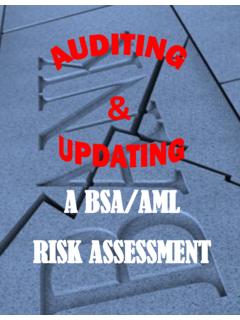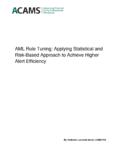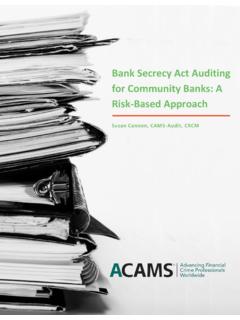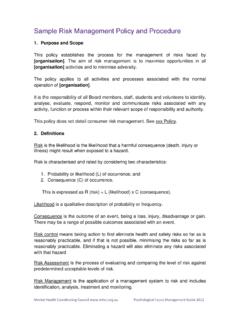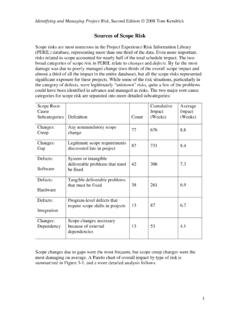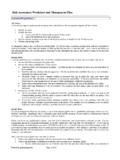Transcription of Compliance Audit: Evaluating and Balancing …
1 Compliance audit : Evaluating and Balancing Country Risk and Regulatory Risk August 2013 Lisa Bowyer, CAMS 2 CONT ENT S Introduction .. 3 Regulatory Risk .. 4 Country Risk .. 5 Obstacles to assessment and evaluation of Country Risk .. 6 HSBC Case 2012 .. 6 Habib bank Case 2012 .. 7 Good regulatory practice .. 7 Auditing the Risk assessment .. 9 Frequency and scope .. 9 Evaluating the Country Risk Assessment .. 9 Assess the Application of the Risk Assessment .. 10 Solutions .. 10 Basel AML Index .. 10 Conclusion .. 11 3 INT RODUCT IO N An initial and on-going risk assessment is the foundation of any Compliance system regardless of its scope and the starting point for an audit of a Compliance system should be to review and evaluate the risk assessment.
2 Whilst a variety of risks have been identified by standard setters and regulators for more than a decade, Evaluating the risk assessment presents a difficult hurdle to clear cleanly to scope the audit and produce a high quality reliable report. The failure to accurately assess and appropriately apply country risk by an institution results in exposure to increased risk and this includes some regulatory risk. The failure by a Compliance auditor to accurately and properly evaluate the risk assessment of country risk may result in further increased regulatory risk where the Institution is mandated to arrange periodic Compliance audits.
3 The ability to achieve the correct balance between regulatory risk and country risk assessments and evaluations is further hindered by the existence and use of white and black lists by regulators which are often reflective of political factors, limited, unreliable or based on old data. In this paper, we identify and explore the Compliance processes reliant on country risk assessments and how to evaluate that in the audit process. We refer to features of reasonable methodologies for country risk assessments highlighting how the assessment can counter regulatory risk arising from regulatory high risk country black lists. Whilst some jurisdictions allow reliance to be placed on introducers and intermediaries if in white list countries (countries with equivalent regulation) but also require enhanced due diligence when clients or transactions involve high risk countries.
4 A small number of regulators list high risk countries, a number define them and many do not include reference to either. Deficient Country Risk Assessment Deficient Evaluation of Country Risk Assessment and application Overall increased risk exposure Increased regulatory risk Deficient Country Risk Assessment by Institution Increased regulatory risk Deficient evaluation of Country Risk Assessment by Auditor 4 REGULAT ORY R IS K The frequency and scope of Compliance audits will directly affect regulatory risk. However, since the evaluation of the risk assessment is the foundation for the audit then any deficiencies in this evaluation could undermine the audit itself and thereby also increase regulatory risk.
5 Where this risk falls depends on the regime. Where the auditor s evaluation of the risk assessment fails to identify weaknesses in the risk assessment, then the auditor will face regulatory risk if the regulator approves auditors either formally or informally. In this case the institution also faces regulatory risk for the deficient risk assessment although it may be afforded some excuse if the auditor does not identify and report on the weakness in its evaluation. However, it may be argued that the risk assessment whilst the foundation for the audit , is affected by so many factors beyond the scope of a Compliance audit1 that the institution should be responsible for the evaluation of its risk assessment by additional independent means.
6 Nonetheless, the auditor needs to be able evaluate the risk assessment as full and objective and its consistent application. The first step is to fully explain to the client the features of a reasonable methodology for risk assessments and stress the importance and relevance of this in the audit . To mitigate any liability, auditors should establish a benchmark for Reasonable Country Risk assessments for the purpose of Compliance audits. This will enable the auditor to focus on the evaluation of the application of the risk assessment. Country Risk Assessment Black and White Lists Compliance Processes audit Flawed Country Risk Assessment Erroneous Evaluation of Risk Assessment Application of Risk Assessment only partially reliable 5 When a risk assessment is evaluated as deficient, communication with the client is necessary and the scope and timing of the audit may be changed.
7 The audit report should clearly note any concerns regarding the risk assessment and limitations of the review to ensure the report is of value and also to manage the auditor s liability and regulatory risk. COUNT RY RIS K Country risk, in conjunction with other risk factors, provides a useful indicator to potential money laundering risks . According to the Wolfsberg Principles, the Evaluating factors that may result in a determination that a country poses a higher risk include if the country is: Subject to sanctions, embargoes or similar measures issued by, for example, the United Nations ( UN ). Identified by the Financial Action Task Force ( FATF ) as non-cooperative in the fight against money laundering or identified by credible sources as lacking appropriate money laundering laws and regulations.
8 Identified by credible sources as providing funding or support for terrorist activities Identified by credible sources as having significant levels of corruption, or other criminal activity2. The Third EU Money Laundering Directive refers to third country equivalence but the proposed 4th Directive will remove the provisions relating to positive "equivalence", as the customer due diligence regime is becoming more strongly risk-based and the use of exemptions on the grounds of purely geographical factors is less relevant. The current provisions of the Third Money Laundering Directive require decisions to be made on whether third countries have anti-money laundering/combating terrorist financing systems that are "equivalent" to those in the EU.
9 This information is then used to allow exemptions for certain aspects of customer due diligence. The non-exhaustive list of geographical risk factors referred to in the Directive, are set to remain the same, only the use and application will change. ANNEX 3 POTENTIALLY HIGHER GEOGRAPHICAL RISK FACTORS ANNEX 2 GEOGRAPHICAL LOWER GEOGRAPHICAL RISK FACTORS (a) countries identified by credible sources, such as FATF public statements, mutual evaluation or detailed assessment reports or published follow-up reports, as not having effective anti-money laundering/combating terrorist financing systems; (a) other EU Member States; (b) countries identified by credible sources as having significant levels of corruption or other criminal activity; (b) third countries having effective anti-money laundering/combating terrorist financing systems.
10 (c) countries subject to sanctions, embargos or similar measures issued by, for example, the United Nations; (c) third countries identified by credible sources as having a low level of corruption or other criminal activity; (d) countries providing funding or support for terrorist activities, or that have designated terrorist organizations operating within their country. (d) third countries which are subject to requirements to combat money laundering and terrorist financing consistent with the FATF Recommendations, have effectively implemented those requirements, and are effectively supervised or monitored in accordance with the Recommendations to ensure Compliance with those Flawed Country Risk Assessment Correct Evaluation of Risk Assessment Can Application of Risk Assessment be evaluated by factoring in flawed risk assessment?
